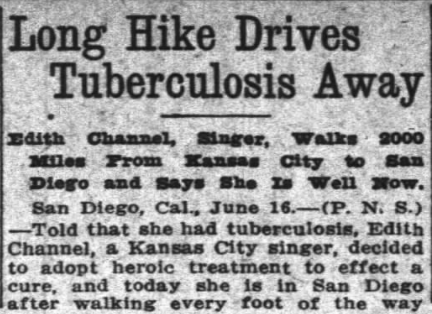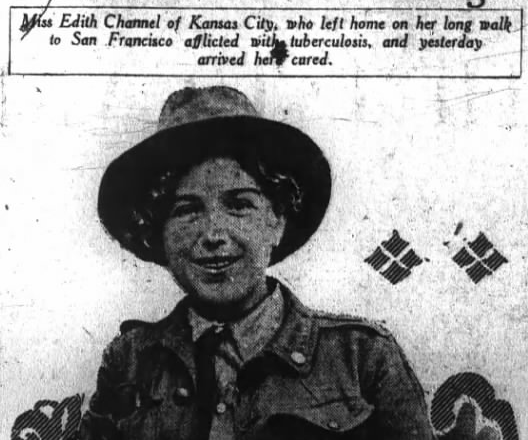1.

Lawrence, Kansas is 41 miles west of Kansas City. The weather in Lawrence on February 4, 1915, was “generally fair,” though there was a chance of snow in the “west portion” that night.
Edith Channel was walking west, into that snow.
2.

There are no reliable, current records of a publication titled “Our Country” based in Kansas City in 1915. At least, there aren’t any easily found online.
The Weekly Post in Kansas City was a real paper. It began publishing in 1912 and continued through the 20s.
The Old Santa Fe Trail led travelers to California in 1915. They might pass sites still haunted by the West’s chronic conflicts. “Comanches and Pawnees,” wrote author C.A. Higgins in 1915, had once made “almost every toilsome mile of the slow passage through Kansas dangerous for the wagon trains that wound slowly across the plains…”
Slowly, perhaps near a walking pace. Edith Channel could have kept up with those wagon trains.
3.
From the Great Bend, Kansas Tribune, an article dated March 15, 1915:
Miss Edith Channel, a Kansas City stenographer who is walking from Kansas City to San Francisco, arrived here last night and this morning left for Pawnee Rock. She is making the journey without funds other than what she earns on the way through selling subscriptions to Our Country, the weekly edition of the Kansas City Post. Miss Channel is a pretty young lady, and a Kansas girl, having been born in Topeka. This winter physicians told her she would have to go west and leave Kansas City or she would be liable to contract tuberculosis so she gave up the stenographic job and decided to go to California. […] She started February 24 and spent ten days visiting a brother in Topeka. The longest walk she has made in one day has been about 15 miles and she has hardly got used to the matter of walking yet but is making a little better time. She left about noon for Pawnee Rock.
She carries 14 pounds of luggage and is pretty cheerful over the prospects of the journey. she expects to get to San Francisco in plenty of time to see the fair and was particularly overjoyed here to find out that the roads were much better in the western part of the state than here. She has to make the trip now on the railroad right of way and thinks the trail road will be better to travel on.
The Fair in San Francisco was the Panama-Pacific International Exposition. It opened March 2, 1915 and closed on December 4 that year.
The same day the Great Bend Tribune published its blurb about Edith’s journey, the Barton County, Kansas Democrat published an article of its own.
“Miss Channel left Kansas City on the 2nd of February,” wrote the Democrat reporter. “She is making the trip alone… to the San Francisco Fair,” the article continued, “and is writing her experiences for the Kansas City Post.”
Edith Channel was “evidently not traveling for her health,” reported the Democrat, “for she has the appearance of being possessed of her full share of that article, and when she starts off impresses one with a confidence in her ability to reach her goal.”
The Democrat stated that Edith was “rather small, and dresses in a walking suit of khaki, and says that except for the fact that her muscles were a little sore from the effect of her unusual exercise she feels none the worse for her experience.
She thought she might reach San Francisco “some time in June.”
4.


5.

On July 21, 1915, The Santa Cruz Evening News published a photo of Edith Channel and a traveling companion, Olive Louise Woodward.
“With the three essentially feminine treasures,” wrote the Evening News, “–a curling iron, a small alcohol lamp and a jar of cold cream, reinforced with a wicked-looking revolver and a canteen, Edith Channel walked 2000 miles, alone–from Kansas City to Los Angeles.”
Edith’s journey, said the Evening News, had been made “to regain her lost health.”
A few days later, on July 24, 1915, the Fort Wayne, Indiana Sentinel published the same photo of Edith and her companion. The accompanying article was simply a longer version of the one published in the Santa Cruz paper.
Edith “never wanted for food,” she said. She’d met “many tramps and travelers,” but “they never molested or insulted me.”
“When I got to the Grand Canyon,” said Edith, she “stopped ten days.”
Edith was traveling the 500 miles between Los Angeles and San Francisco with Olive Louise Woodward, “a nineteen-year-old girl who has already traveled all the way from Derby, England, to Vancouver, thence to Los Angeles, unaccompanied, though not on foot.”
Olive’s intention was “to gain experience, scare away a natural timidity of nature and eventually win her way into the movies.”
The girls were planning on 15 to 20 miles a day.
6.

Edith Channel reached San Francisco at the end of July. “Upon arrival,” reported the San Francisco Chronicle, “she went at once to the tuberculosis booth in the Palace of Education at the exposition.”
Edith there explained to the head physician that her father and grandfather had died from the disease.
The physician examined her and “pronounced the young woman in perfect health.”
“A complete cure,” he said, “The exercise and out-of-doors life did it.”
7.


Edith’s age was given in articles as 23 and 25. The US Federal Census from 1900 listed a 23-year-old Earl Dinsmore living with an Edith and Lester Channel, both 24. A Kansas State Census taken in March 1905 shows a 29-year-old Edith Channel living Lincoln, Kansas with a J.J. Channel and a boy of 12, Carl Hill. The next Federal Census 5 years later finds an Edith aged 34 living in Pennsylvania with a Chester Channel.
It seems likely Edith really was 39 or 40 when she died, rather than the ages she gave to various newspaper reporters along her journey west.
Some articles about her suicide stated she had been employed by the Panama-Pacific International Exposition, which closed just before she died.
The lies and secrets Edith kept as she carried her pack across the west in the last year of her life don’t matter now. She was a singer; sure. A writer–okay. A photographer? Whatever.
Finding the first trace of her journey in those old papers, addled, distracted and pressured reporters haphazardly gathering the bits of her story on the way–that long-distance view was too compelling to not trace. Like piloting a time-traveling drone quietly buzzing above her head as she strode the tracks and the roads.
The vast buzzsaw of the Great War was sweeping a continent an ocean away, and soon enough, America would join the fight. Anarchists and spies were setting bombs up and down the East Coast. Inventors and innovators were flourishing.
In Kansas, a woman decided to make a new younger self. She might have just been a liar. But maybe she saw that she still looked young and saw an opportunity to grab something before it faded away. Even if she didn’t have tuberculosis–the white plague–when she arrived at the Exposition, even if that was another fiction, it no longer matters. She packed her curling iron, cold cream, a lamp, and a gun. She set out on the Santa Fe Trail. She had a purpose, that much is clear.
She must have found something she needed on her walk. It might have been her English friend Olive. It might have been the moments of fame in the papers, always a few pages back from the war reports.
Of course, it didn’t fix whatever was broken within. And Edith seems to have been forgotten outside the microfilm machines scanning papers across the years, the scanners digitizing those images.
Until now.
I don’t truly know why Edith Channel made her journey. But across 100 years I can see her, a ghost in khaki with her soft hat and her pack, under the hard stars and those great skies out west that terrify, and awe.
I know her fate.
I don’t want her to stop walking.
Someone I would like to have known.
I think I would have too.
Waaaoooo
Pretty awesome
I guess back then it was easy enough to assume a new age, even a new identity. In the long run I wonder what the walk was indeed meant to accomplish. If it was fame, then however small or fleeting, her mission was accomplished.
This reminded me of a book, The Unlikely Pilgrimage Of Harold fry. An old man walking 600 miles just to deliver a letter himself.
Going by the last photo of hers, she just looks adventurous. She well could have been a travel blogger here on WordPress.
Very nice story.
Very cool story! Makes me want to travel…
History always amazing life is a adventure
Inspiring! Thank you!
Agree!
Great piece of history/writing. Thank you!
nice
Awesome work
I walked from Ann Arbor Michigan to South Bend Indiana once. It was a week long bar hop. (On foot.) I was trying to get to Chicago, but I ran out of money. 🙁
I like this very much.
Reblogged this on Aste Mudfoot and commented:
This is a very cool story. Sometimes the journey doesn’t need a reason or a why, it’s just about the journey. And I guess, when she stopped walking, she lost the motivation to keep going.
Reblogged this on S. K. Epperson and commented:
A victory that turns into a complete mystery…
Enticing read, sir.
What an interesting story.
Reblogged this on edgarmeloecosta.
Reblogged this on TRUTH ODG.
So very well written. Thanks for sharing this most interesting Story.
Waouhhh
Great piece of writing as a fiction writer this definitely gets my imagination into overdrive!
👍
Intriguing tale well told.
Reblogged this on #GetCoNNECTED and commented:
#woman #history
Cool
That’s incredible- how did you even know to look for this? I guess we all at some point (and more likely this point is middle age) want the chance to reinvent ourselves, even if only temporarily. She mentioned she wanted to be in the movies- perhaps the disappointment if rejection drove her to despair. She should have kept on walking. There was no need to run.
It was pure chance. I often scan old online images of newspapers and the photo of Edith and her companion grabbed my attention. I read the brief article and just wanted to know more. When I got to the last articles after she reached her destination I was blown away and had to write about it.
(Guess that was the same chance that brought me to reading your blog 🙂
I’m so glad you took the time to research and write this then— really enjoyed reading about Edith and set me thinking about there really being nothing new under the sun. People then, people now, different circumstances, same hopes, dreams, delusions and disappointments.
Reblogged this on Welcome.